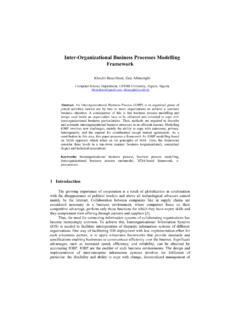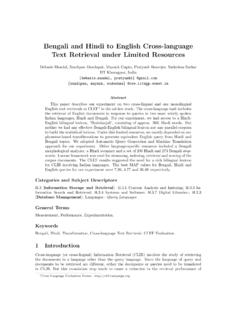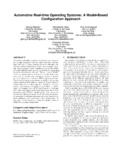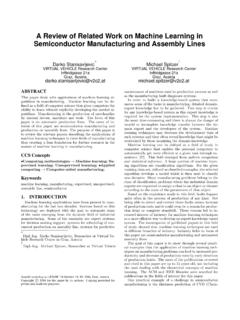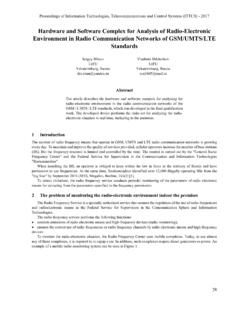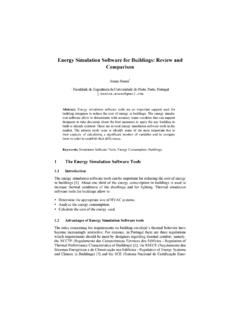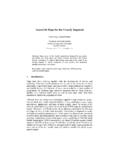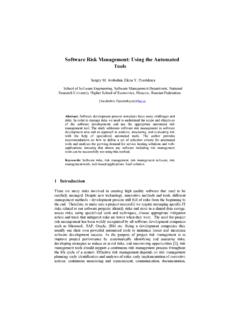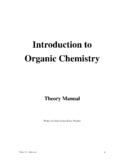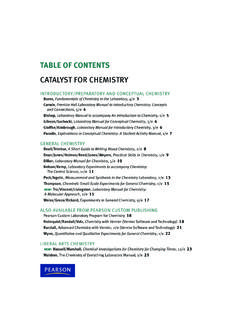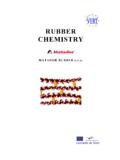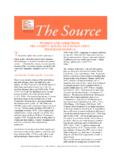Transcription of VEGA-QSAR: AI inside a platform for predictive …
1 1 VEGA-QSAR: AI inside a platform for predictive toxicology Emilio Benfenati1, Alberto Manganaro1 and Giuseppina Gini2 1 IRCCS- Istituto di Ricerche Farmacologiche Mario Negri, Milano, Italy {benfenati, 2 DEIB, Politecnico di Milano, Italy Abstract. Computer simulation and predictive models are widely used in engineering, much less considered in life sciences. We present an initiative aimed to establish a dialogue within the community of scientists, regulators, industry representatives, offering a platform which combines the predictive capability of computer models, with some explanation tools, which may be convincing and helpful for human users to derive a conclusion. The resulting system covers a large set of toxicological endpoints. 1 Introduction predictive toxicology is using models to predict biological endpoints, in particular toxicity, without making real experiments.}
2 The concept of Structure-Activity Re-lationship (SAR) is that the biological activity of a chemical can be related to its molecular structure. When quantified, this relationship is known as QSAR . A QSAR model makes use of existing experimental toxicity data for a series of chemicals to build a model that relates experimentally observed toxicity with mo-lecular descriptors in order to predict the toxicity of further chemicals. The term predictive toxicology [1] has been introduced by the AI community to indicate this approach to toxicology . A series of regulations require producing information about the safety of the chemical substances, such as the European legislation REACH. This regulation states that for each chemical circulating in Europe a complete dossier on physico-chemical, environmental and toxicological properties has to be compiled.
3 In order to prevent an over-usage of animal testing, REACH foresees the use of alternative methods, including predictive programs. Life sciences are heavily impacted by the development of methods for data col-lection and analysis; they are moving from an analytical approach to a modelling approach. An important step in this direction is played by the changing mind from purely statistics usage of data to the data mining and machine learning view of the 2 recent years. Good models should (1) explain patterns in data; (2) correctly predict the results of new experiments or observations; and (3) be consistent with other ideas (models, beliefs). Of course the (3) requirement is the most critical one. Today some QSAR models have proved to offer a valuable alternative to the classical in vivo methods [2]. Nevertheless, most of the QSAR models are not trusted by their targeted users, for several reasons [3], including the misunderstand-ing of the technology.
4 We decided to cope with those issues through an open plat-form dedicated to the stakeholders potentially interested in using QSAR models. This paper presents the developed platform . The user needs, captured during several workshops, interviews and exercises carried on through four recent Euro-pean projects (DEMETRA, CAESAR, ORCHESTRA and ANTARES) have strongly guided the platform development. According to the user s requirement to keep as confidential the chemical structures, our solution is implemented both as a web-based application and as down-loadable software. 2 Using the VEGA-QSAR platform Several institutes contributed to the development of the platform , called VEGA-QSAR, including regulators and public bodies in Europe and USA. VEGA freely offers tens of models for properties such as persistence, logP, bioconcentration factor (BCF), carcinogenicity, mutagenicity, skin sensitization.
5 The initial nucleus of VEGA models derives from the CAESAR models1. Other models have been added to simulate the models developed by the partners; this is the case of models developed by EPA (US Environmental Protection Agency) and ISS (Istituto Superiore di Sanit ) for instance. All the models have been published in scientific literature before incorporating into VEGA. Moreover all the models have been successfully benchmarked against the few commercially available systems. The steps of the workflow are clearly indicated in the GUI: insert the list of the molecules identifiers, choose where to send the prediction output, ask predic-tion, and get results. The input can be given in different standard formats used in the chemical domain, including SMILES and SDF files [4]. To avoid the well-known problems about the non-unique representations VEGA transforms all the chemical structure into a unified internal string format.
6 Figure 1 show, as an example, the output screen of the BCF model [5] with the prediction and the most similar compounds with their experimental and predicted values. BCF is a dose value, however for regulation classes are assigned according to thresholds. Since the uncertainty of the prediction can be calculated, it is graphically shown for each molecule as a worst-case analysis, as in Figure 2. 1 Furthermore, the model provides other pieces of information useful to the evaluator, such as a plot showing the experimental values of the training set (Figure 3), to check for possible unusual behaviour of the target compound. Figure 1 Prediction of the bioconcentration factor (logBCF) for the compound and the most similar structures available in the dataset, with experimental and predicted values.
7 Figure 2 The BCF model suggests the classification in the classes defined in REACH. Figure 3 The predicted logBCF value (red dot) inside the experimental values of the dataset. 4 The overall reliability of the prediction is measured by combining statistical values, elements of case based reasoning, and possibly presence of active sub-structures; the possible reasons of concern are underlined. All those considerations are weighted and summed up in an index (in 0 1) that is called Applicability Domain Index (ADI). Moreover the user can apply different models to the same endpoint, and VEGA suggests the best integration, as illustrated in Section 5. 3. AI inside VEGA VEGA is mainly the result of the data driven and knowledge discovery ap-proaches. The models implemented arise from different methods.
8 At least three families are represented: (1) rule based expert systems, usually codified as the presence of chemical substructures called structural alerts (SA), defined by ex-perts, as in Toxtree >7]; (2) data miners that extracts relevant fragments from the analysis of their correlation with the endpoint, as in SARpy [6]; (3) regression models that use molecular descriptors and non linear methods - ANN, SVM - as the mentioned BCF model; (4) ensemble methods as random forests as in Devel-opmental toxicity; (5) hybrid models that mix the above methods as in CAESAR-mutagenicity. The toxicity domain poses significant challenges to the AI methods. The first is the lack of available knowledge about reasons and mechanisms of toxicity for many of the endpoints that make it impossible to apply deductive approaches.
9 The purely symbolic approach can be used for mechanistic interpretation , which is a vague indication about the toxicological pathway associated to that chemical on the basis of the presence of a specific chemical subgroup. Moreover, even in case some SAs are known, their presence is only a sufficient condition for toxicity; so the absence of SA in a molecule does not guarantee its safety. This is the reason why we have developed new methods as in SARpy >6@, with the aim of discovering both new SA and neutral substructures (NS) of the mole-cule that may reinforce the classification as safe for molecules not containing SA but instead containing some NS. QSAR systems make more use of probabilistic AI than symbolic AI, with the consequent problems of difficulty in understanding the results. There is generally a trade-off between prediction quality and interpretation quality of a model.
10 Inter-pretable models are desired to make expert decisions; however those models suf-fer because the generalizations necessary to get them may be flawed by lack of enough data. To avoid the risk of excess generalization, often QSARs are simple linear regression in the small population of a chemical class. Those models have no predictive value outside this small population. In VEGA models are generally not intended to provide transparency in se, but high accuracy on new data that the model has not used in training; since transpar- ency is needed, this is obtained adding extra visualization and explanation features to the models, as presented in the previous subsection. What is needed is a way to predict new chemicals and to deal with real sub-stances that generally are mixtures of quite complex molecules, as in dyes and fuel, and that can be better modelled as large SAs and NSs.
